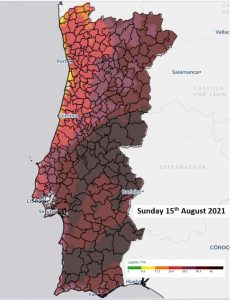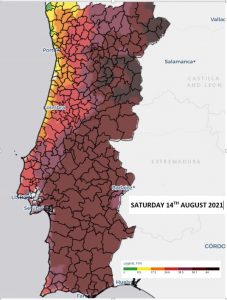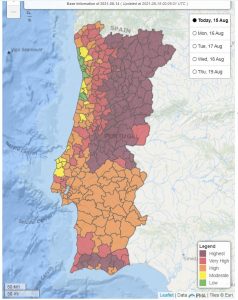Meeting of Infarmed 27th July 2021
The meeting took place this morning, the first since 28th May 2021, to listen to the experts concerning the pandemic.
This week, and after the meeting with the experts, the Government will define the new rules in view of the evolution of the pandemic and, above all, taking into account the progress of vaccinations.
The President of the Republic, Marcelo Rebelo de Sousa, the Prime Minister, António Costa, the President of the Assembly of the Republic, Eduardo Ferro Rodrigues, the Minister of Health, Marta Temido, and representatives of the political parties will hear the interventions of several specialists. from 10:00 am at the headquarters of the National Medicines Authority, in a meeting that had not taken place since 28 May.
This page will be updated upon the start of the meeting.
The Minister of Health opened the meeting at 10.03 hrs
André Peralta Santos, from DGS, revealed that the incidence is higher than 400 cases per 100,000 inhabitants. However, the rate of increase in the number of cases “has been decreasing”.
There is greater incidence in the metropolitan areas of Lisbon and Porto, as well as in the Algarve. In Lisbon and the Algarve, there is already “a trend of stabilization or descent”. In Porto, there are still “growth areas”, since, here, the resurgence of the pandemic occurred after it had occurred in Lisbon.
Since early June there has been an “increasing trend” in admissions, with 198 in ICU and 900 in total on 25 July. At the moment, there is an occupancy of 78% of the reference value of 255 beds. The age group with the highest occupation in the ICU is between 40 and 59 years old.
Until recently (week 26 of the pandemic), only 2% of those admitted to the ward had the complete vaccination schedule. This value rises to 5% in the case of those admitted to the ICU.
Ana Paula Rodrigues, from INSA, considered that the moment is of “high incidence”, although with “a tendency to stabilize”. “We will be close to the peak,” she said. Over 60 years, due to the vaccine, there are fewer cases, and with less severity.
There is a smaller number of hospitalizations in the age groups with greater vaccination coverage. In young adults (20 to 40 years old), there is an increase in hospitalizations.
This is followed by the intervention of epidemiologist Henrique de Barros, who will talk about what to expect in winter. The goal for the next cold season, he explains, should be to have a “better winter” than the previous one, resorting to vaccination and respect for safety rules
New wave – small – in winter”
The model presented in January – in which the number of covid cases would be residual in September – will escape prediction due to delays in vaccination and the appearance of the Delta variant.
According to Henrique de Barros, for every 5 degrees decrease in average temperatures, there will be a 30% increase in cases.
Taking into account all the variables, the cold and people vaccinated, “we can expect a new wave – small, with little emphasis on admissions and deaths – for the winter”.
The proposed plan revealed by Raquel Duarte is divided into four levels, the 1st being the current (50%-50% full vaccination) and the 4th implying group immunity.
There are three “fundamental” rules for any level: the ventilation of spaces, the use of the digital certificate and the “self-assessment of risk”.
The “general rules” between levels 1 and 3 include the use of telecommuting “whenever possible”, the observance of detachment and the use of a mask “in closed environments and public events” (and whenever it is not possible to ensure adequate distance ).
In catering, the plan proposes a maximum of 6 to 8 people per table inside the spaces between levels 1 to 3. Outside, the limit is 10 people per table on level 1 and 15 people on level 2. On level 3, there will no longer be limits.
As for sport and big events, if you cannot control them, they should not take place between levels 1 and 2.
Raquel Duarte proposes that the deconfinement process should take into account lethality and variation in admissions, as well as the “complete vaccination coverage rate”.
Raquel Duarte asked her to bet more and more on the ventilation of interior spaces to “prepare for Autumn/Winter”.
The specialist wants to “keep transmission indicators” (incidence and R(t)) as “core indicators”. However, he proposes to include indicators of clinical severity and impact of mortality in the risk assessment of the pandemic.
“We are in a position to update the incidence threshold to 480 cases per 100,000 inhabitants,” he said. It also recommended that you continue to wear a mask.
The specialist Andreia Leite stated that the current situation in the UK implies “the acceptance of a high number of infected people”, which could affect the normal functioning of society, such as absenteeism from work or school and, consequently, the congestion of hospitals. It may also favor the appearance of new variants.
Andreia Leite, from the National School of Public Health at the Universidade Nova de Lisboa, presented the proposal to revise the risk matrix, stressing that Portugal is not yet in a position to be completely unconfined, but rather to reduce the restrictive measures needed to control the situation. .
Thus, the proposal goes through a “transition phase”, updating the matrix to “480 cases per 100,000 inhabitants in the last 14 days”, with a limit of 255 beds in intensive care. Indicators such as transmission rate (Rt) and incidence should remain central, he warned, and indicators of clinical severity should also be measured,
The advance of vaccination “should influence the gradualism of deconfinement”.
But for now it is necessary to maintain the essential measures, such as the use of a mask.
Andreia Leite recalled the Netherlands’ retreat from the announced disconfinement and the noted risks to the release process announced in the United Kingdom.The risks of total deconfinement, he said, would imply “the acceptance of virus circulation and a high number of cases, accepting the possibility of long covid, even with limited understanding, disruption in schools, absenteeism from work, problems with services such as public health It can also lead to problems in intensive care. As well as the emergence of new variants.”
Ausenda Machado, from the INSA, revealed that the first dose of mRNA vaccines (Pfizer and Moderna) provide 37% protection for the group between 65 and 79 years of age and 35% for those aged 80 and over.
João Paulo Gomes, from INSA, stated that, currently, the Delta variant represents 98.6% of the cases registered in Portugal. The UK variant only accounts for 1% of cases. Manaus (Brazil) is “residual” (maximum of 0.4%) and South Africa has not been detected in recent weeks.
The Lambda variant “has no expression” in Portugal and will not, in principle, be “a cause for concern”. This variant is mainly present in countries like Peru or Chile.
All regions have a Delta variant prevalence above 95%. In the North region, where the variant in question took longer to become hegemonic, this is also already happening.
With complete vaccination, this protection increases, respectively, to 78% and 68%.
The Delta variant is already “dominant” in European Union countries.
The population is “increasingly immune” and “increasingly able to deal with covid-19”. However, “new combinations of mutations” are expected, something the expert considers “natural” due to the levels of vaccination.
Carla Nunes, from the National School of Public Health, revealed that younger people have lower risk perception values in case they come to be infected by covid-19 (only 37%, against 60% of the older group).
“We can imagine a winter in which life can get very close to what it was before,” he said, stressing the importance of vaccinating the youngest.
“If we don’t vaccinate the children, we’re going to have a spike in cases.”
57.1% of respondents say it is “difficult or very difficult” not to socialize with family or friends. The highest value (62.1%) is between 16 and 25 years old.
The greatest resistance to the vaccine (that is, those who do not want to take the vaccine or who have not yet decided) is found in the most active age groups, between 26 and 65 years, with about 25%. The highest number of respondents who answered that they had no intention of taking it was between 46 and 54 years old (19.9%).
Among respondents who do not want to get the vaccine, 57% said they did not have enough information. 50% said they were afraid of developing side effects and 40.7% considered that vaccines were not, in their opinion, effective.
20.9% prefer to gain immunity through contagion, 14% responded that covid-19 is not a dangerous disease for themselves and 7% believe they do not need the vaccine because they have already been contaminated. Only 2.3% said they did not believe in vaccines.
This was followed by the intervention of Vice Admiral Gouveia e Melo, who began by recalling that, throughout the year, the arrival of vaccines against covid-19 did not always correspond to expectations.
According to the person in charge of the task-force, in the 50-year-old age group there are about 4% to be vaccinated and 10% in the 40-year-old.
If the DGS decides to vaccinate children between 12 and 15 years old, the process will be done in September. The vaccination of teenagers starts on the weekend of August 14th
The goal of immunizing 70% of the Portuguese population with the first dose remains for the beginning of August: around the 8th, estimates Gouveia e Melo.
“We are winning the vaccination race, but to relax this rhythm is to give oxygen to the virus”, concluded the coordinator of the task-force
..


 Today taking into account the FWI, there is an increase in fire risk compared to yesterday, with around 45% of the mainland at MAXIMUM, (nearly 100 municipalities).
Today taking into account the FWI, there is an increase in fire risk compared to yesterday, with around 45% of the mainland at MAXIMUM, (nearly 100 municipalities). Determining the risk of the spreading and behaviour of rural fires – the Rural Fire Index (FWI)
Determining the risk of the spreading and behaviour of rural fires – the Rural Fire Index (FWI) The FWI Rural Fire Index determines how quickly a fire will start and spread and comprises the following six indices that quantify the effects of fuel moisture and wind on fire behaviour.
The FWI Rural Fire Index determines how quickly a fire will start and spread and comprises the following six indices that quantify the effects of fuel moisture and wind on fire behaviour. As forecast today, there is an increase in fire risk compared to yesterday, with around 45% of the mainland at MAXIMUM, (nearly 100 municipalities).
As forecast today, there is an increase in fire risk compared to yesterday, with around 45% of the mainland at MAXIMUM, (nearly 100 municipalities).